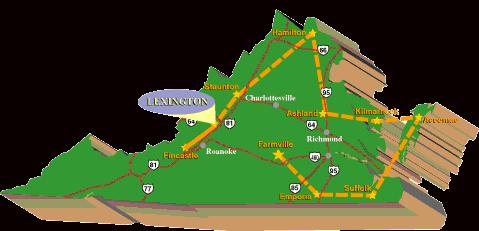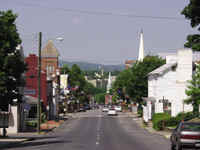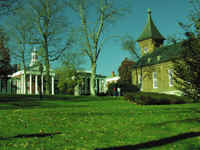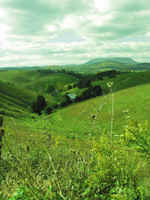
Download
in PDF Format
The
population in Lexington is 6,867 with a land area of 2.5 square miles.
People in Lexington are serious about
their welcomes, and have been for the last 140 or more years. They say 140
because the �speaking tradition� (as it is called) originated just
after the Civil War when Robert E. Lee became president of Washington
College � now Washington & Lee University. He formally instituted
the tradition of greeting everyone you meet on the street, but most likely
that was something the locals were doing anyway. It is a hospitable town
with a centuries-old tradition of hospitality.
|

Main
Street, Lexington |
The spring of 2004 is the beginning of a
renaissance of interpretive American history. Three of Lexington�s major
museums, The Stonewall Jackson House Museum, the VMI Cadet Museum, and the
George C. Marshall Research Library and Museum, are undergoing renovation
and revitalization. There�s still plenty to see and do. A special
exhibit on Stonewall Jackson is on display at the Rockbridge Historical
Society, in the Campbell House across from the Visitor Center on
Washington Street.
Do the streets look familiar? They just
might. What makes the city so attractive to visitors makes it a popular
location for television and movies. The most recent film that features
Lexington was �Gods and Generals.� When you get to the corner of
Washington and Main streets there is a sign for a millenary shop. It�s a
leftover from the movie �Sommersby.� Nothing really had to be changed
other than adding mulch to the streets, because really, not much has
changed. That�s one of the best things about Lexington. It looks pretty
much the way it did before the Civil War, and for that matter, pretty much
like it was afterwards. It is what it is because of what didn�t happen
here. Which when you think about it is a good thing. When you look up and
down the streets you are looking at the same landmarks that have been
visible since the earliest days. House Mountain, dominating the western
horizon of the city, served as a landmark for those heading south, up the
Great Valley Turnpike, as they made their
|

The
George C. Marshall Museum is just one of several museums in
Lexington, a city steeped in American history. |
way West. These intrepid travelers
often paused here before they tackled the trek across the Allegheny
Mountains. Many of those decided they had come far enough west, and they
stayed, building the city we now enjoy. Now the mountain stands at the
crossroads of two interstates (81 and 64) and parallel to the original
trails, (U.S. highways 11 and 60). Their location is no coincidence.
Lexington has grown and prospered, but it hasn�t lost any of its charm
or visitor appeal. It�s a city that is meant to be enjoyed slowly �
walk the streets or take a horse-drawn carriage.
Two of America�s most distinctive
colleges, Washington & Lee University (W&L) and the Virginia
Military Institute (VMI), are part of Lexington�s downtown. W&L is
the nation�s ninth-oldest institution of higher learning; VMI is the
oldest state-supported military college in the nation.
In 1796, George Washington gave $20,000
in canal stock to endow what became Washington College. To this day
students receive a small amount of money each year from the monies
generated by this gift. Following the Civil War, Confederate Gen. Robert
E. Lee, a former superintendent of the U.S. Military Academy at West
Point, became president of the school. He believed that education was the
way to bring the war-torn country into the future. His decision to come to
Lexington was an easy one � his son was already there as a professor at
VMI. George Washington was his wife�s grandfather. It was a family
thing.
|

The
Classical Revival style of the Washington & Lee Columnade is
spectacular---tall white columns grace the brick buildings. Across
from the Colmnade is Lee Chapel, whose lower level houses a
wonderful museum. |
Both schools welcome visitors, both have
museums, and the architectural styles of both are truly textbook examples.
The Classical Revival style of the W&L Colonnade is spectacular �
tall, white columns grace the red brick buildings. Crowning the central
hall is a statue of George Washington. Across from the Colonnade is Lee
Chapel. Although it is called a chapel it was never consecrated; Lee meant
for it to be a meeting place for the student body. The simple, plain
interior is dominated by a marvelous statue of General Lee. The lower
level houses a wonderful museum that traces the connection of the Lee and
Washington families and the history of the college. Make sure you step
outside the glass doors on the lower level to see the grave of Traveller,
Lee�s famous war horse. Visitors often leave apples, carrots and loose
change.
Collegiate Contrast
Adjoining the campus of W&L is VMI.
Stark, spartan and gothic, VMI stands in contrast to the graceful,
columned red brick buildings of its neighbor. In spite of its austere
appearance, VMI welcomes visitors. Tours are offered daily. The Institute,
referred to as �the Post,� traces its origin to 1819 when Virginia
established an arsenal on the �frontier.� The soldiers assigned to
this duty didn�t have a lot to do and found ways to amuse themselves,
which did not amuse the townsfolk. A local attorney, John Thomas Lewis
Preston, established the concept of educating the soldiers while they
weren�t guarding the guns. Preston became the first professor.
�Cadets� (both men and women) are required to live in the barracks. If
you visit on a Friday afternoon during the academic year you might witness
a full dress parade. It�s quite a sight as the Corps of Cadets
accompanied by band and bagpipes stream out of the barracks across the
parade ground in the shadow of House Mountain. It�s definitely a
highlight you shouldn�t miss. As you look around the parade ground, note
all the statues that surround the parade ground. Two � �Stonewall
Jackson� and �Virginia Mourning Her Dead� � were sculpted by Moses
Ezekiel, a graduate who became a world-renowned artist.
While you are on post make sure you stop
to visit the George C. Marshall Research Library and Museum that honors
the most distinguished graduate of VMI. Marshall created the plan for the
recovery of Europe following World War II, for which he received the Nobel
Peace Prize. For the next five years this building will also house the VMI
Museum, the oldest museum in the Commonwealth of Virginia. Jackson
Memorial Hall, the usual location, is under renovation and is not
scheduled to reopen until 2007. Even in temporary quarters the collection
features spectacular items that you don�t want to miss. You will see the
raincoat that Stonewall Jackson was wearing when he was shot (look for the
bullet hole in the left sleeve) and the mounted hide of his war horse,
Little Sorrel.
Lots to Do
|

The
distinctive profile of House Mountain dominates the western
horizon of the city. |
If you are interested in outdoor
recreation, history, shopping, art or family entertainment you will find
it all, no matter what time of year you visit. Good food and lodging are
high on any visitor�s list. You will find plenty of both. It�s a total
travel package � it�s all right here! So where do you start? That�s
the easy part. No matter which direction you approach you will find
trailblazer signs directing you to the Lexington-Rockbridge Area Visitor
Center on Washington Street. That�s where you want to begin your visit.
Travel counselors will help you organize your visit, providing you with
brochures, great maps and helpful information.
Are you hungry yet? Lexington has some
great places to eat. You name it, it�s served downtown. From down-home
barbecue to the finest cuisine, take your pick. All restaurants welcome
visitors, just wear shoes and shirts. Don�t worry about bringing a tie.
Just want something to drink or something sweet? There are two coffee
shops, a bakery, a bistro, oh, and two candy stores, a tea room, and a
homemade ice cream shop.
Good Fun, Too
|

In
the shadow of House Mountain, the VMI Regimental Pipe band
performs on the university's parade ground. |
Downtown has more than good food. There
are six excellent art galleries. You will find everything from Chinese
brush painting to fine art photography to sculpture, woodcarving, pottery,
jewelry. Is it made by hand? It�s here. All are within a two-block
radius. Both college campuses have magnificent art collections, too.
That�s one of the best things about Lexington � for the most part you
can park your car and walk just about everywhere.
And don�t worry about losing your way,
which just doesn�t happen in Lexington. Just stop, pause for a moment
and someone is sure to ask, �Can I help you?� It�s Lexington
hospitality at its best.